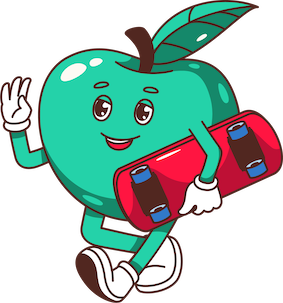Y3. Lesson 5. Traditional time names
Prior learning: Solfa time names
Duration: 30 minutes
Materials: Woodblocks or claves
Keywords: Beat, rhythm, singing, chanting, partners, rhymes, circle games.
Difficulty: ![]()
Prepare
Present
Traditional British and American time names
Practise

British and American time names in music refer to the terminologies used to describe note durations or rhythmic values in music notation.
- Semibreve / Whole Note:
- British: Semibreve
- American: Whole note
- Description: The longest note in common use, equivalent to four beats in 4/4 time.
- Minim / Half Note:
- British: Minim
- American: Half note
- Description: Worth half a semibreve or two beats in 4/4 time.
- Crotchet / Quarter Note:
- British: Crotchet
- American: Quarter note
- Description: One beat in 4/4 time, or a quarter of a semibreve.
- Quaver / Eighth Note:
- British: Quaver
- American: Eighth note
- Description: Half a crotchet or one-eighth of a semibreve.
- Semiquaver / Sixteenth Note:
- British: Semiquaver
- American: Sixteenth note
- Description: A quarter of a crotchet or one-sixteenth of a semibreve.
![]() Students discover British and American note values.
Students discover British and American note values.
- At this juncture, it is advisable to refresh student's prior learning concerning solfa time names.
- The minim was known as too, the crotchet as ta, two quavers as ti-ti and a semiquaver as tika-tika.
- Project or print the chart showing the British and American equivalent note values.
- Explain that musicians have used traditional names for hundreds of years.
- Teach that the longest note in music is called a semibreve, or whole note. In quadruple time it lasts for four beats.
- The next note is half as long as a semibreve and is called the minim and lasts for two beats.
- Half of a minim is called a crotchet, or quarter note and lasts for one beat.
- Half of a crotchet is called a quaver, or eighth note and lasts for half a beat.
- Finally, half of a quaver is called a semiquaver, or sixteenth note and lasts for a quarter beat.
 Rhythmic development
Rhythmic development
![]() Students revise and discover new information about notes.
Students revise and discover new information about notes.
- Students should know that a note can consist of a notehead, a stem and one or more flags.
- Project the graphic showing the noteheads, stems and flags used in music.
- Discuss with the class the different notes and their formal names.
- The single quaver is now shown as separate from paired quavers (previously known as time names ti-ti) and having one flag.
- A single semiquaver is shown, but it is unlikely that students will be expected to use this at this grade level.
 Creative movement
Creative movement
![]() Students revisit a classic circle game.
Students revisit a classic circle game.
- Students take a partner and hold hands.
- Lead the class in singing Bluebells.
- Students should move their joined arms up and down to the beat.
- On the first words, 'evee, ivee, over,' students turn back-to-back.
- The second time those words are sung, students turn again to face each other.
- Students must quickly find a new partner at the song's end, and the game recommences.
 Listening
Listening
![]() Students watch and listen to the Australian national Anthem.
Students watch and listen to the Australian national Anthem.
- Play the video of the Melbourne Symphony Orchestra with vocalist Dami Im.
- When the video is finished, ask students if they know the name of the music and its purpose.
- Ask students what they felt when listening to the music and the singer.
- Ask why the national anthem is important to many Australians.
- Ask for other examples of where music is used for a purpose. Examples may include weddings, funerals, sports events, and concerts.
- If time permits, play the video again and ask how many instruments students recognise.
 Visual learning
Visual learning
![]() Students determine the name of each note shown on the staff.
Students determine the name of each note shown on the staff.
- Project or print out the worksheet.
- Begin by asking what is the name of the sign on each staff [treble clef].
- Ask students to write the name of each note shown using a capital letter.
- Remind students that a simple way to remember notes in spaces is to use the word FACE.
- For notes that sit on lines, then the rhyme Every Good Boy Deserves Fruit (or similar) is helpful to remember.

 Instruments
Instruments
![]() Students play a simple song using the notes A & B.
Students play a simple song using the notes A & B.
- Students should be familiar with the two notes learned thus far, A and B.
- Remind students to use a good finger position for each note and the left thumb positioned appropriately.
- Using a gentle tonguing technique, students should play the song. Remind students that the first and second measures have two crotchets (quarter notes) followed by a minim (half note).
- The third measure has four crotchets, and the last measure has two minims.
- Students should remember to count each beat in their heads, including those for rests.
 Part work
Part work
![]() Students and the teacher clap in canon.
Students and the teacher clap in canon.

 Assess
Assess
Suggested lessons
Y1. Beat II

Y1. Beat III

Y1. Beat IV

